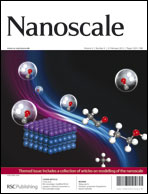In situ growth BaTiO3 nanocubes and their superlattice from an aqueous process†
Abstract
Ordered aggregated BaTiO3 nanocubes with a narrow size distribution were obtained in an aqueous process by using bis(ammonium lactate) titanium dihydroxide (TALH) as Ti source in the presence of


 Please wait while we load your content...
Please wait while we load your content...